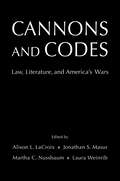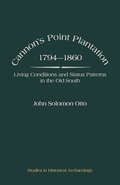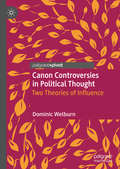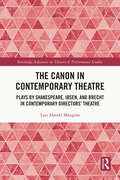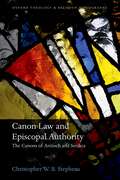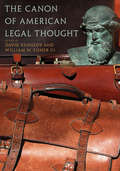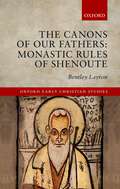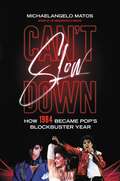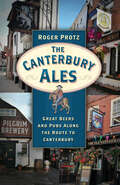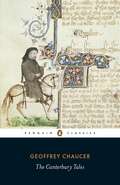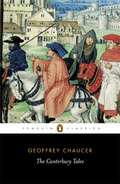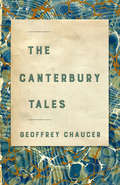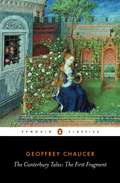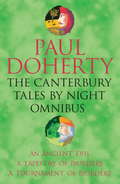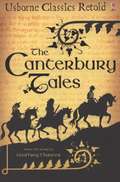- Table View
- List View
Cannons and Codes: Law, Literature, and America's Wars
It can be said that western literature begins with a war story, the Iliad; and that this is true too of many non-Western literary traditions, such as the Mahabharata. And yet, though a profoundly human subject, war often appears to be by definition outside the realm of structures such as law and literature. When we speak of war, we often understand it as incapable of being rendered into rules or words. Lawyers struggle to fit the horrors of the battlefield, the torture chamber, or the makeshift hospital filled with wounded and dying civilians into the framework of legible rules and shared understandings that law assumes and demands. In the West's centuries-long effort to construct a formal law of war, the imperative has been to acknowledge the inhumanity of war while resisting the conclusion that it need therefore be without law. Writers, in contrast, seek to find the human within war--an individual story, perhaps even a moment of comprehension. Law and literature might in this way be said to share imperialist tendencies where war is concerned: toward extending their dominion to contain what might be uncontainable. Law, literature, and war are thus all profoundly connected--and it is this connection this edited volume aims to explore, assembling essays by preeminent scholars to discuss the ways in which literary works can shed light on legal thinking about war, and how a deep understanding of law can lead to interpretive insights on literary works. Some of the contributions concern the lives of soldiers; others focus on civilians living in war zones who are caught up in the conflict; still others address themselves to the home front, far from the theatre of war. By collecting such diverse perspectives, the volume aims to illuminate how literature has reflected the totalizing nature of war and the ways in which it distorts law across domains.
Cannon's Point Plantation, 1794 - 1860: Living Conditions and Status Patterns in the Old South
by John Solomon OttoCannon's Point Plantation, 1794 - 1860
The Canoe Boys: The First Epic Scottish Sea Journey By Kayak
by Alastair Dunnett'It's too late in the year!' they were advised, but they still did it. By canoe from Bowling to Kyle of Lochalsh with numerous stops along the way, Alastair Dunnett and Seamas Adam spent a heady Autumn in the 1934 meandering up the glorious West Coast of Scotland. On their way they sent reports back to the Daily Record informing the readers of their progress and the people they met along the way. Their account makes fascinating reading as they were hailed by onlookers and bystanders wherever they went as 'The Canoe Boys'. Escapades as varied as running the infamous tide-rush of the Dorus Mhor to a balmy harvest working on Calve Island off Mull, quenching their thirst with a mug of drammach (oats and water) are related in superb, lyrical style by Dunnett. This is an adventure story of youthful exuberance and of how life once was lived before the war changed everything for ever. Fully illustrated with archival material and contemporary press cuttings, this cult travelogue will find a new market among the growing number of adventure kayakers taking to Scotland's coastal waters.
Canon Controversies in Political Thought: Two Theories of Influence
by Dominic WelburnThis book explores the meaning of 'influence', which has played a central role in the formation of the canon, or tradition, of Western political thought. Via a critical overview of the relative fortunes of influence studies in the history of political thought, literary theory, and – at times – the history of art and poetry, it is possible to identify a dominant theory of the term. Nietzschean and ‘emanational’ in nature, thanks largely to the work of Harold Bloom, this particular theory views influence as mere power and represents a broadly accepted meaning in twentieth century thought. Canons or traditions of thought came to be institutions in themselves reflecting prevalent social and political inequalities. To be sure, a theory of influence as power came to be seen as complicit in arbitrary canon formation, across a range of disciplines. The book argues, ultimately, that a second theory of influence, imported from Mary Orr’s work on intertextuality, affords a rival perspective and a more positive, intergenerational meaning of influence. Orr’s ‘braided rope’ theory of influence allows for the development of a plurality of canons each capable of constructing new histories for a variety of epistemic communities. The existence of agonistic, rival canons presents pedagogical questions for all teachers of political theory, but one that can be potentially navigated by a new understanding of influence, in the Orrian tradition.
The Canon in Contemporary Theatre: Plays by Shakespeare, Ibsen, and Brecht in Contemporary Directors’ Theatre (ISSN)
by Lars Harald MaagerøThis book explores the relationship between contemporary theatre, particularly contemporary theatre directors, and the dramatic canon of plays.Through focusing on productions of plays by three canonical playwrights (Shakespeare, Ibsen, and Brecht) by eight contemporary European directors (Michael Buffong, Joe Hill-Gibbins, and Emma Rice from the UK, Christopher Rüping from Germany, Thorleifur Örn Arnarsson from Iceland, and Kjeriski Hom, Alexander Mørk-Eidem, and Sigrid Strøm Reibo from Norway) the book investigates why and how the theatre continues to engage with canonical plays. In particular, the book questions the political and cultural implications of theatrical reproductions of the literary canon. Drawing on Chantal Mouffe’s theories of agonism and ‘critical art,’ the book investigates whether theatrical reproduction of the canon always reconstitutes the hegemonic values and ideologies of the canon, or whether theatrical interventions in the canon can challenge such values and ideologies, and thereby also challenge the dominant ideologies and hegemonies of contemporary culture and society.This study will be of great interest to academics and students in drama and theatre, particularly those who work with theatre in the twenty-first century, directors’ theatre, and the political impact of theatre.
The Canon in Contemporary Theatre: Plays by Shakespeare, Ibsen, and Brecht in Contemporary Directors’ Theatre (ISSN)
by Lars Harald MaagerøThis book explores the relationship between contemporary theatre, particularly contemporary theatre directors, and the dramatic canon of plays.Through focusing on productions of plays by three canonical playwrights (Shakespeare, Ibsen, and Brecht) by eight contemporary European directors (Michael Buffong, Joe Hill-Gibbins, and Emma Rice from the UK, Christopher Rüping from Germany, Thorleifur Örn Arnarsson from Iceland, and Kjeriski Hom, Alexander Mørk-Eidem, and Sigrid Strøm Reibo from Norway) the book investigates why and how the theatre continues to engage with canonical plays. In particular, the book questions the political and cultural implications of theatrical reproductions of the literary canon. Drawing on Chantal Mouffe’s theories of agonism and ‘critical art,’ the book investigates whether theatrical reproduction of the canon always reconstitutes the hegemonic values and ideologies of the canon, or whether theatrical interventions in the canon can challenge such values and ideologies, and thereby also challenge the dominant ideologies and hegemonies of contemporary culture and society.This study will be of great interest to academics and students in drama and theatre, particularly those who work with theatre in the twenty-first century, directors’ theatre, and the political impact of theatre.
Canon Law and Episcopal Authority: The Canons of Antioch and Serdica (Oxford Theology and Religion Monographs)
by Christopher W. StephensChristopher Stephens focuses on canon law as the starting point for a new interpretation of divisions between East and West in the Church after the death of Constantine the Great. He challenges the common assumption that bishops split between 'Nicenes' and 'non-Nicenes', 'Arians' or 'Eusebians'. Instead, he argues that questions of doctrine took second place to disputes about the status of individual bishops and broader issues of the role of ecclesiastical councils, the nature of episcopal authority, and in particular the supremacy of the bishop of Rome. Canon law allows the author to offer a fresh understanding of the purposes of councils in the East after 337 particularly the famed Dedication Council of 341 and the western meeting of the council of Serdica and the canon law written there, which elevated the bishop of Rome to an authority above all other bishops. Investigating the laws they wrote, the author describes the power struggles taking place in the years following 337 as bishops sought to elevate their status and grasp the opportunity for the absolute form of leadership Constantine had embodied. Combining a close study of the laws and events of this period with broader reflections on the nature of power and authority in the Church and the increasingly important role of canon law, the book offers a fresh narrative of one of the most significant periods in the development of the Church as an institution and of the bishop as a leader.
Canon Law, the Expansion of Europe, and World Order (Variorum Collected Studies)
by James MuldoonThe articles in this volume trace the development of the theory that humanity forms a single world community and that there exists a body of law governing the relations among the members of that community. These ideas first appeared in the writings of the medieval canon lawyers and received their fullest development in the writings of early modern Spanish intellectuals. Conflict and contact with ’the infidel’ provided a stimulus for the elaboration of these ideas in the later Middle Ages, but major impetus was given by the English subjugation of Ireland, and by the discovery of the Americas. This body of work paved the way for the modern notions of an international legal order and universal norms of behavior usually associated with the publication of Hugo Grotius’s work in the seventeenth century.
Canon Law, the Expansion of Europe, and World Order (Variorum Collected Studies)
by James MuldoonThe articles in this volume trace the development of the theory that humanity forms a single world community and that there exists a body of law governing the relations among the members of that community. These ideas first appeared in the writings of the medieval canon lawyers and received their fullest development in the writings of early modern Spanish intellectuals. Conflict and contact with ’the infidel’ provided a stimulus for the elaboration of these ideas in the later Middle Ages, but major impetus was given by the English subjugation of Ireland, and by the discovery of the Americas. This body of work paved the way for the modern notions of an international legal order and universal norms of behavior usually associated with the publication of Hugo Grotius’s work in the seventeenth century.
The Canon of American Legal Thought (PDF)
by David Kennedy William W. FisherThis anthology presents, for the first time, full texts of the twenty most important works of American legal thought since 1890. Drawing on a course the editors teach at Harvard Law School, the book traces the rise and evolution of a distinctly American form of legal reasoning. These are the articles that have made these authors--from Oliver Wendell Holmes, Jr., to Ronald Coase, from Ronald Dworkin to Catherine MacKinnon--among the most recognized names in American legal history. These authors proposed answers to the classic question: "What does it mean to think like a lawyer--an American lawyer?" Their answers differed, but taken together they form a powerful brief for the existence of a distinct and powerful style of reasoning--and of rulership. The legal mind is as often critical as constructive, however, and these texts form a canon of critical thinking, a toolbox for resisting and unravelling the arguments of the best legal minds. Each article is preceded by a short introduction highlighting the article's main ideas and situating it in the context of its author's broader intellectual projects, the scholarly debates of his or her time, and the reception the article received. Law students and their teachers will benefit from seeing these classic writings, in full, in the context of their original development. For lawyers, the collection will take them back to their best days in law school. All readers will be struck by the richness, the subtlety, and the sophistication with which so many of what have become the clichés of everyday legal argument were originally formulated.
The Canons of Our Fathers: Monastic Rules of Shenoute (Oxford Early Christian Studies)
by Bentley LaytonThis book is the first publication of a very early set of Christian monastic rules from Roman Egypt, accompanied by four preliminary chapters discussing their historical and social context and their character as rules. These rules were found quoted in the writings of the great Egyptian monastic leader Shenoute. Designed for a federation of monks and nuns who banded together about 360 CE—forming the so-called "White Monastery Federation"—the rules date back to the fourth and fifth centuries. New historical evidence is presented for the founding of the Federation. Providing almost the earliest evidence for Christian communal (cenobitic) monasticism, the rules depict many intimate aspects of ascetic practice. Details of monastic daily life are mentioned in passing in the rules, and the author uses these details to describe their picture of monastic life under five general topics: the monastery as a physical plant, the human makeup of the community, ascetic observances, the hierarchy of authority, and the daily liturgy. The book includes a clear English translation of the rules accompanied by the original Coptic text, amounting to five hundred and ninety-five entries.
The Canso d'Antioca: An Occitan Epic Chronicle of the First Crusade
by Carol Sweetenham Linda M. PatersonThe Canso d'Antioca is a fascinating text which deserves more attention than it has received. It is a fragment of a much larger epic describing the events of the First Crusade, related to the Old French Chanson d'Antioca but with many unique features. As such it presents a double interest to scholars of both history and literature. It is a source text for the First Crusade with information not contained in any other source. It is also an early and seminal text for Occitan epic, few examples of which survive. And arguably it represents the first work of vernacular verse history in France, raising fundamental questions about the junction of epic and historiography. This is the first published edition of the text since Paul Meyer's version in 1884. It is based on the single extant manuscript of the Canso found in Roda in Northern Spain and now in Madrid, accompanied by a translation into English on facing pages. The text is supported by detailed notes and a glossary of proper names cross-referenced to all major First Crusade sources. The introduction discusses in detail the history of the text and manuscript, the value of the Canso as a historical document, and its place both within the historical tradition of the Crusade and within Occitan literary tradition and 12th-century vernacular historiography.
The Canso d'Antioca: An Occitan Epic Chronicle of the First Crusade
by Carol Sweetenham Linda M. PatersonThe Canso d'Antioca is a fascinating text which deserves more attention than it has received. It is a fragment of a much larger epic describing the events of the First Crusade, related to the Old French Chanson d'Antioca but with many unique features. As such it presents a double interest to scholars of both history and literature. It is a source text for the First Crusade with information not contained in any other source. It is also an early and seminal text for Occitan epic, few examples of which survive. And arguably it represents the first work of vernacular verse history in France, raising fundamental questions about the junction of epic and historiography. This is the first published edition of the text since Paul Meyer's version in 1884. It is based on the single extant manuscript of the Canso found in Roda in Northern Spain and now in Madrid, accompanied by a translation into English on facing pages. The text is supported by detailed notes and a glossary of proper names cross-referenced to all major First Crusade sources. The introduction discusses in detail the history of the text and manuscript, the value of the Canso as a historical document, and its place both within the historical tradition of the Crusade and within Occitan literary tradition and 12th-century vernacular historiography.
Can't Slow Down: How 1984 Became Pop's Blockbuster Year
by Michaelangelo MatosThe definitive account of pop music in the mid-eighties, from Prince and Madonna to the underground hip-hop, indie rock, and club scenesEverybody knows the hits of 1984 - pop music's greatest year. From "Thriller" to "Purple Rain," "Hello" to "Against All Odds," "What's Love Got to Do with It" to "Wake Me Up Before You Go-Go," these iconic songs continue to dominate advertising, karaoke nights, and the soundtracks for film classics (Boogie Nights) and TV hits (Stranger Things). But the story of that thrilling, turbulent time, an era when Top 40 radio was both the leading edge of popular culture and a moral battleground, has never been told with the full detail it deserves - until now. Can't Slow Down is the definitive portrait of the exploding world of mid-eighties pop and the time it defined, from Cold War anxiety to the home-computer revolution. Big acts like Michael Jackson (Thriller), Prince (Purple Rain), Madonna (Like a Virgin), Bruce Springsteen (Born in the U.S.A.), and George Michael (Wham!'s Make It Big) rubbed shoulders with the stars of the fermenting scenes of hip-hop, indie rock, and club music. Rigorously researched, mapping the entire terrain of American pop, with crucial side trips to the UK and Jamaica, from the biz to the stars to the upstarts and beyond, Can't Slow Down is a vivid journey to the very moment when pop was remaking itself, and the culture at large - one hit at a time.
Can’t We Just Print More Money?: Economics in Ten Simple Questions
by Rupal Patel The Bank of England Jack Meaning'A well-written treat' Professor David Spiegelhalter, author of The Art of Statistics'An enjoyable introduction' The Times'Entertaining and essential' Laura Whateley, author of Money: A User's Guide__Why are all my clothes made in Asia? How come I'm so much richer than my great-great-grandma? And what even is money?Whether you're buying lunch, looking for a job, or applying for a mortgage, the thing we call 'the economy' is going to set the terms. A pity, then, that many of us have no idea how the economy actually works.That's where this book comes in. The Bank of England is Britain's most important financial institution, responsible for printing money, regulating banks and keeping the economy running smoothly. Now, the Bank's team take you inside their hallowed halls to explain what economics can - and can't - teach us about the world. Along the way, they offer intriguing examples of econ in action: in financial crises and Freddo prices, growth stages and workers' wages. Accessible, authoritative and surprisingly witty, this is a crash course in economics and why it matters.__'A great place to start your economic journey. With the Bank of England as your guide, this accessible book shows how economics affects so many aspects of our daily lives.' Dr Linda Yueh, author of The Great Economists
The Canterbury Ales: Great Beers and Pubs Along the Route to Canterbury
by Roger ProtzThe pilgrims in Chaucer's The Canterbury Tales begin their journey in a London inn and they stay at many more as they wend their way to Becket's tomb. Leading beer writer Roger Protz remains faithful to the route, visiting pubs of historic interest and breweries old and new before embarking on the Pilgrims' Way from Winchester to Canterbury, revealing fascinating history as well as a few more spots to sample a pint.The Canterbury Ales is a feast of a book for those who love good beer, pubs, breweries … and Chaucer's literary masterpiece.
Canterbury and the Gothic Revival
by Lawrence LyleCanterbury Cathedral’s medieval Gothic image survived centuries of religious discord, neglect and Georgian ’improvements’. From 1800, a new generation was re-inspired by the prevalent architectural and artistic ’Gothick’ vogue. At this time, a passionately ambitious young architect, William Butterfield, created a Gothic missionary college in two years, and the Dean of Canterbury, who wanted the Cathedral to rival St Peter’s, Rome, began the rolling repair programme continuing in today’s Appeal. Priests, bishops and Gothic enthusiasts carried the style from there to parish churches, industrial cities and the colonies. With more than fifty illustrations, including a striking colour section, this book will delight lovers of Canterbury and of the Gothic style everywhere.
The Canterbury Book of Days (Book Of Days Ser.)
by Paul CramptonTaking you through the year day by day, The Canterbury Book of Days contains a quirky, eccentric, amusing or important event or fact from different periods of history, many of which had a major impact on the religious and political history of England as a whole. Ideal for dipping into, this addictive little book will keep you entertained and informed. Featuring hundreds of snippets of information gleaned from the vaults of Canterbury’s archives, it will delight residents and visitors alike.
The Canterbury Tales
by Geoffrey ChaucerAt the Tabard Inn in Southwark, a jovial group of pilgrims assembles, including an unscrupulous Pardoner, a noble-minded Knight, a ribald Miller, the lusty Wife of Bath, and Chaucer himself. As they set out on their journey towards the shrine of Thomas a Becket in Canterbury, each character agrees to tell a tale. The twenty-four tales that follow are by turns learned, fantastic, pious, melancholy and lewd, and together offer an unrivalled glimpse into the mind and spirit of medieval England.
The Canterbury Tales
by Geoffrey ChaucerIn The Canterbury Tales Chaucer created one of the great touchstones of English literature, a masterly collection of chivalric romances, moral allegories and low farce. A story-telling competition between a group of pilgrims from all walks of life is the occasion for a series of tales that range from the Knight's account of courtly love and the ebullient Wife of Bath's Arthurian legend, to the ribald anecdotes of the Miller and the Cook.
The Canterbury Tales
by Geoffrey ChaucerWhile Geoffrey Chaucer composed several magnificent works of poetry, his reputation as “the father of English literature” rests mainly on The Canterbury Tales, a group of stories told by assorted pilgrims en route to the shrine of Thomas à Becket in Canterbury Cathedral. From the mirthful and bawdy to the profoundly moral, the tales, taken in their entirety, reflect not only the manners and mores of medieval England, but indeed, the full comic and tragic dimensions of the human condition. Considered the greatest collection of narrative poems in English literature, The Canterbury Tales was composed in the Middle English of Chaucer’s day, possibly to be read aloud at the court of Richard II. However, their grandeur, humor, and relevance are timeless, as readers of this authoritative edition will discover.Penguin Random House Canada is proud to bring you classic works of literature in e-book form, with the highest quality production values. Find more today and rediscover books you never knew you loved.
The Canterbury Tales
by Geoffrey ChaucerWhile Geoffrey Chaucer composed several magnificent works of poetry, his reputation as “the father of English literature” rests mainly on The Canterbury Tales, a group of stories told by assorted pilgrims en route to the shrine of Thomas à Becket in Canterbury Cathedral. <P><P>From the mirthful and bawdy to the profoundly moral, the tales, taken in their entirety, reflect not only the manners and mores of medieval England, but indeed, the full comic and tragic dimensions of the human condition. <P><P>Considered the greatest collection of narrative poems in English literature, The Canterbury Tales was composed in the Middle English of Chaucer’s day, possibly to be read aloud at the court of Richard II. <P><P>However, their grandeur, humor, and relevance are timeless, as readers of this authoritative edition will discover. <P><P>Penguin Random House Canada is proud to bring you classic works of literature in e-book form, with the highest quality production values. Find more today and rediscover books you never knew you loved.
The Canterbury Tales: The First Fragment
by Geoffrey Chaucer Michael AlexanderThe most complete of all remaining surviving fragments sections of The Canterbury Tales, the First Fragment contains some of Chaucer's most widely enjoyed work. In The General Prologue, Chaucer introduces his pilgrims through a set of speaking portraits, drawn with a clarity that makes no attempt to conceal their peculiarities. The four tales that follow - those of the Knight, Miller, Reeve and Cook - reveal a wide variety of human preoccupations: whether chivalrous, romantic or simply sexual. Brilliantly bawdy and subtly complex, each of these tales is alive with Chaucer's skills as a poet, storyteller and creator of comedy.
The Canterbury Tales By Night Omnibus: Three gripping medieval mysteries
by Paul DohertyThe Canterbury Tales by Night Omnibus features the first three novels in Paul Doherty's mystery series charting the progress of Chaucer's pilgrims, and the tales they tell along the way. Includes An Ancient Evil, A Tapestry of Murders and A Tournament of Murders. Perfect for fans of Ellis Peters and Susanna Gregory.An Ancient Evil: As the travellers gather at the start of a pilgrimage to Canterbury, they agree to amuse themselves on their journey with evening tales of mystery, terror and murder. So begins the Knight's tale. It opens with the destruction of a sinister cult during the reign of William the Conqueror, and then moves to Oxford some two hundred years later where terrible murders are being committed. The Abbess of the Convent of St Anne's, believes the murders are connected with the legends of the cult and petitions the King for help... A Tapestry of Murders: As Chaucer's pilgrims continue towards Canterbury, they choose the Man of Law to narrate the next tale of fear and sinister dealings. In August 1358, the adulterous Dowager Queen Isabella, the 'She Wolf of France', lies dying of the pestilence in the sombre fortress of Castle Rising, where her 'loving' son has kept her incarcerated. But as in life so in death Isabella causes intrigue, violence and murder. Nicholas Chirke, an honest young lawyer, is brought in to investigate strange events following her death - and quickly finds himself at his wits' end trying to resolve the mysteries before a great scandal unfolds. A Tournament of Murders: While Chaucer's pilgrims settle for the night, the Franklin narrates a mysterious, bloody tale... In 1356 the Black Prince has won his resounding victory at Poitiers. As impoverished knight Gilbert Savage lies dying in the wake of the fight he tells his squire, Richard Greenele, that the story of his parents perishing during the plague is untrue. Richard, if he wishes to uncover what really happened, must travel to Colchester and seek out a sealed letter telling the truth of his parentage, and a most macabre confession that will set him on a mission for revenge from which there is no turning back...
Canterbury Tales (Usborne Classics Retold) (PDF)
by Sarah CourtauldA simplified and shortened retelling of the Chaucer classic which remains faithful to the original Middle English text in the treatment of the story.
